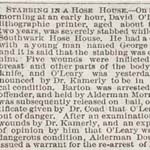Section IV. The Commercial Lithographers in Philadelphia, 1828-1878
More than 500 artists, lithographers, printers, and publishers are known to have worked in the field of lithography in Philadelphia between 1828 and 1878. These individuals entered the trade through various channels: serving three- to four-year apprenticeships beginning at about fourteen to sixteen years of age; transferring from related print trades; arriving as émigrés trained abroad; and through family connections. Some worked as artists, lithographers, and/or printers, while others performed only one function. This exhibition attempts to represent all those involved in this revolutionary printing process, but a number of them proved significant for their artistry, longevity, or commercial viability. A few of these notable lithographers are highlighted in this section.
A comprehensive online Biographical Dictionary of Philadelphia Lithographers can be accessed at http://www.librarycompany.org/pos/posdictionary.htm
Commercial Lithographers in Philadelphia, 1828-1878
By 1850 there were eleven lithographic establishments in Philadelphia, almost double the number in 1840. Near the end of the decade, about thirty firms operated around 200 lithographic presses in the city. The trade increased to include about forty-five firms by 1871, with most clustered east of Broad Street near and along the 300 blocks of Chestnut and Walnut streets, not far from where Kennedy & Lucas operated. The industry employed nearly 300 men, women, and “youths” by the start of the 1870s when wages for master printers had increased to $25-30 from $8-10 a week in 1862.
Pennsylvania-born males formed the majority of the trade between 1828 and 1878 with at least twenty-five percent of the identified Philadelphia lithographers of German heritage. Most lived in North Philadelphia, particularly the Northern Liberties, with pockets of lithographers residing in Center City and South Philadelphia. According to the censuses for 1850 and 1860, most local lithographers (about forty percent) were in their twenties. Later, in the 1870s, the predominant age shifted to include more men between thirty and fifty years of age and fewer under twenty. The increasing average age of those in the profession reflects the decreasing number of apprentices by the later 19th century. Click Map below for larger view (PDF).
Click on the thumbnails below to browse the items in this section of the exhibition.
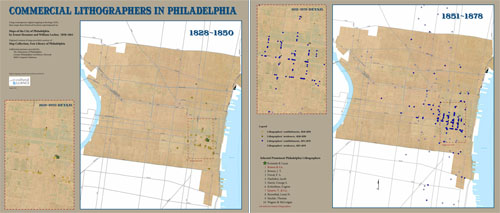
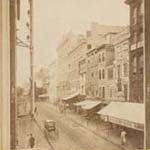

![[Chestnut Street, East of Fourth Street (Philadelphia: James Cremer], photographed ca. 1867, published ca. 1875). Albumen print on stereograph mount.](images/thumbs/2th4.4.jpg)
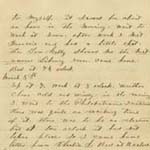
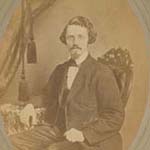
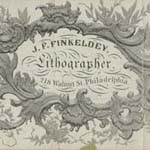
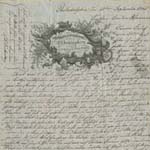
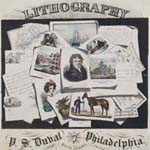
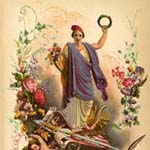

![David C. Scattergood, “Wagner & McGuigan Lithographic Establishment.” Wood engraving in The Philadelphia Merchants’ & Manufacturers’ Business Directory for 1856-57 (Philadelphia: Prepared & Published by Griswold & Co., [1856]).](images/thumbs/2th4.12.jpg)


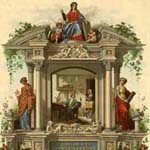
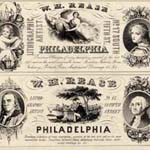

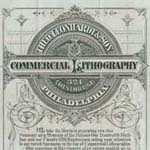
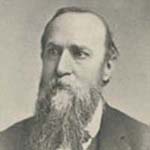
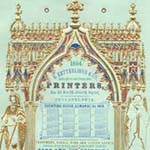
![“The Late Jacob Ha[ehnlen],” in Joseph Jackson, Some Notes Toward a History of Lithography in Philadelphia (Philadelphia, 1900). Courtesy of the Historical Society of Pennsylvania.](images/thumbs/2th4.21.jpg)

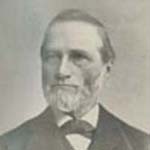

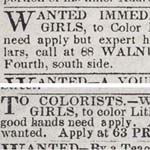
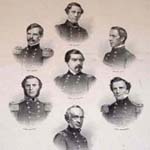
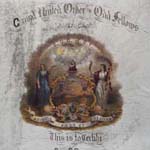
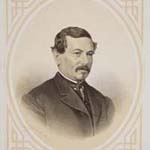
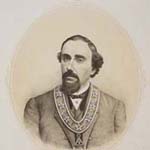
![Max Rosenthal, L. N. Rosenthal. Lithographic Office, Removed to N.W. Cor. of Fifth & Chestnut Sts. Philadelphia. (Philadelphia: Lith. & Printed in Colors at the Establishment [of L. N. Rosenthal], October 1856). Gift of Charles A. Poulson.](images/thumbs/2th4.30.jpg)
